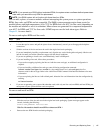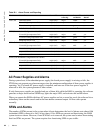
System Boot | 55
A
System Boot
This appendix provides instructions to boot the E600i system from the BOOT_USER prompt.
The E600i System Boot Process
When you supply power to the E600i system, the system performs a series of power-on self-tests. RPM,
and line card Status LEDs blink during initialization. No user interaction is required as long as the boot
process proceeds without interruption. Observe the process on your console monitor and note the
message output on the display. When the boot process is complete, the RPM and line card Status LEDs
remain online (green) and the console monitor displays the command line interface (CLI) prompt,
Force10>.
The RPM cards in the E600i system contain an internal flash memory card (flash:). This is the default
storage area for the boot files and the startup configuration file. Upon system power up or a system reset,
the boot process uses parameters stored in non-volatile random access memory (NVRAM) to boot the
system.
Each RPM is equipped with a slot for an external flash memory card (slot0:). You can copy the image
files and configuration files to the external flash device on the primary RPM. You can also begin your
boot process by accessing a remote server containing the boot image and system image files. When you
configure your system to boot, you can specify the boot preference order: primary, secondary, or default
in the in the
BOOT_USER mode and the CLI mode.
NOTE: The E600i system supports up to a 40-character file name length, up to a 180-character local file path
length, and up to a 256-character remote file path length.
For information about the flash memory card, see
Chapter 11, Using a Flash Memory Card
.
Booting from the BOOT_USER Prompt
To get into the BOOT_USER mode, you can issue a break control sequence (CNTL+^) to interrupt the
automatic boot process or if you experience boot problems. This mode allows you to modify the
parameters necessary to manage the boot process. Only console port access is enabled for the
BOOT_USER mode.


















